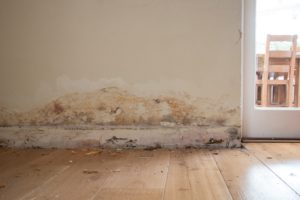
A new survey reveals how damp problems damage property values, increases the time that homes are on the market and reduces let-ability. Safeguard Director Hudson Lambert examines the issue.
While damp in housing may feel like a concern of the 1970s or 80s, it still proves to be a significant issue in a good number of British homes. The English Housing Survey: Homes 2011 (published in 2013) found that, although declining, the number of dwellings with damp problems was as many as 600,000 dwellings.
And it’s still a huge issue. While issues such as cramped rooms, bad smells or even overgrown gardens deter people from property purchases; a new YouGov survey, commissioned by Safeguard Europe, reveals that while all of those would turn many people off, by far the most common – and widely experienced – deterrent is damp.
 Of the 1,296 potential buyers surveyed in August this year, 91% said that if they came across damp in a property they would be discouraged from making an offer. YouGov also asked people what they would do should they discover the presence of damp once their purchase was underway; 42% said that they would simply walk away, with 48% saying that they would demand a reduction in price, some by as much as 20%.
Of the 1,296 potential buyers surveyed in August this year, 91% said that if they came across damp in a property they would be discouraged from making an offer. YouGov also asked people what they would do should they discover the presence of damp once their purchase was underway; 42% said that they would simply walk away, with 48% saying that they would demand a reduction in price, some by as much as 20%.
For those looking to sell property, the message is clear: thoroughly identify and deal with damp problems before putting it on the market. The implicit finding of the survey is that investing in remedial works now would lead to a better price and less time on the market.
Common problem
The YouGov survey also revealed how common damp is. In total, the pollsters talked to 2,030 people – both homeowners and renters – and found that almost half of them (49%) had lived in a property with damp problems.
The proportion of people who have lived with damp rises to 52% when only those who rent are considered, perhaps indicating that landlords are more reluctant than homeowners to invest in remediation. However, landlords should be aware that damp can be classed as a statutory nuisance under the Environmental Protection Act 1990.
There is also awareness that damp walls are much poorer insulators than dry ones; Other Safeguard research has shown that masonry treated externally with a water-repellent cream, for instance, can reduce heat loss by up to 29%. Better still, such a treatment would be classified under VAT Notice 708/6 as an energy-saving measure that qualifies for a reduced VAT rate of 5%. Nearly half of those polled (48%) said that increased heat loss through damp walls would be a worry.
Too tough to tackle?
The findings of the survey reveal a common perception that damp is a difficult and time-consuming problem to fix. In fact, this is only true in a very small percentage of cases.
The most important step in dealing with damp is to understand what is causing it. ‘Rising damp’ is often given as a cover-all diagnosis, however a qualified timber and damp surveyor would be able to identify specific causes – for example, rain penetration caused by a leaking gutter.
Condensation is probably the most common cause of damp, a problem sometimes exacerbated by the latest generation of super-airtight homes. Rain penetration is also a frequent occurrence, either due to damaged or deteriorating masonry or leaking gutters and pipework. For those specifying damp treatments it’s important that the solution is appropriate to the specific cause – or combination of causes – of damp.
It’s also crucial for specifiers to keep abreast of the latest technologies and innovations which can speed up the process of treatment, while maintaining performance and quality. For example, damp-proofing rods, combined with ‘express’ replastering systems can slash the time required to transform a damp room to less than two days.
There will also be situations where damp cannot be eliminated at source. Here, products such as damp-proof coatings for floors and walls may be the right solution.
Having established the correct diagnosis and identified the appropriate solution; the next major concern in realising successful damp treatment is finding a competent and trusted contractor. The survey gives some insight into what potential clients look for in a contractor: damp-proofing certification was the most commonly cited factor (78%), followed by the quality of guarantees (67%) and of materials (58%).
Informed advice
There is still much misperception and misinformation about the causes and treatment of damp among developers, landlords and householders alike. Reputable manufacturers and contractors must join forces to combat this by providing informed advice and solutions so that treating damp is seen as a viable and valuable course of action, rather than something to be avoided at all costs.
Safeguard Europe’s range of market-leading, proven solutions is supported by the company’s own highly qualified and experienced staff. The support and know-how they offer is extended to contractors, specifiers and property owners and includes technical advice, specification help, research and even in-house laboratory analysis of plaster and masonry.








